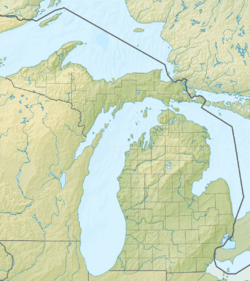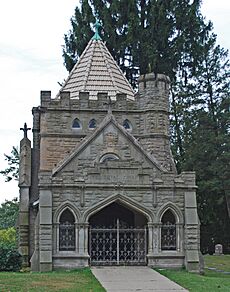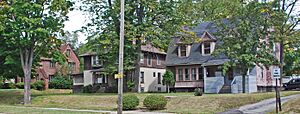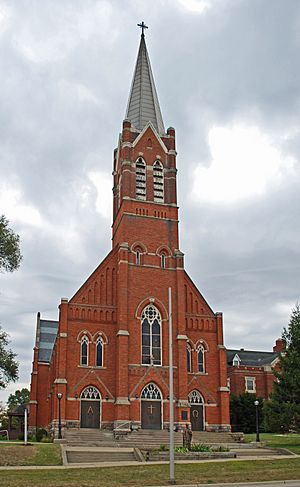Pontiac, Michigan facts for kids
Quick facts for kids
Pontiac, Michigan
|
||
|---|---|---|
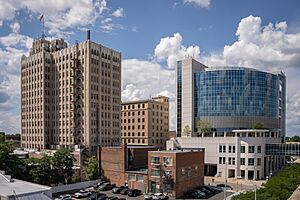
Downtown Pontiac
|
||
|
||
| Nickname(s):
The Yak, Yaktown
|
||

Location within Oakland County
|
||
| Country | ||
| State | ||
| County | Oakland | |
| Settled | 1818 | |
| Incorporated | 1837 (village) 1861 (city) |
|
| Named for | Pontiac | |
| Government | ||
| • Type | Mayor–council | |
| Area | ||
| • Total | 20.25 sq mi (52.46 km2) | |
| • Land | 19.89 sq mi (51.50 km2) | |
| • Water | 0.37 sq mi (0.95 km2) | |
| Elevation | 922 ft (281 m) | |
| Population
(2020)
|
||
| • Total | 61,606 | |
| • Density | 3,098.11/sq mi (1,196.16/km2) | |
| Time zone | UTC−5 (Eastern (EST)) | |
| • Summer (DST) | UTC−4 (EDT) | |
| ZIP Codes | ||
| Area codes | 248 and 947 | |
| FIPS code | 26-65440 | |
| GNIS feature ID | 0635224 | |
Pontiac is a city in Oakland County, Michigan, in the United States. It is the main city of Oakland County. Pontiac is about 26 miles (42 km) northwest of downtown Detroit. It is part of the larger Detroit area. In 2020, about 61,606 people lived in Pontiac.
The city was started in 1818. It was one of the first European-American settlements in Michigan near Detroit. Pontiac was named after Chief Pontiac, a famous leader of the Ottawa Tribe. He lived in the area before European settlers arrived.
Pontiac became well-known for its General Motors car factories in the 1900s. These factories were very important to the city's economy. They made GMC trucks and the famous Pontiac cars. The Pontiac car brand was named after the city. General Motors stopped making Pontiac cars in 2010.
In 1975, the city built the Pontiac Silverdome. This was a large stadium where the Detroit Lions football team played until 2001. Super Bowl XVI was held there in 1982. The Silverdome was used for concerts and events until it was taken down in 2018. Now, an Amazon warehouse stands on its site.
Contents
History of Pontiac
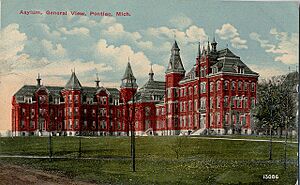
For thousands of years, Native American people traveled through what is now Pontiac, Michigan. They used the Saginaw Trail and the Nottawassippi River. The river's name was later changed to the Clinton River by settlers. The Saginaw Trail was a key path from Saginaw Bay to the Detroit River.
The first European-American settlers came to Pontiac in 1818. They followed the Saginaw Trail from Detroit. They chose this spot because the trail and river met here. Two years later, Pontiac became the county seat for Oakland County. This happened because a group called The Pontiac Company wanted their land to be the county seat.
The Pontiac Company had 15 members. Solomon Sibley of Detroit was their leader. Solomon and his wife, Sarah Sibley, helped pay for the first buildings. Sarah Sibley was very active in helping the new settlers. The Sibley-Hoyt house is believed to be one of Pontiac's first buildings.
In the 1820s, Elizabeth Denison, a free Black woman, worked for the Sibleys. They helped her buy land in Pontiac in 1825. She was likely the first Black woman to buy land in Michigan Territory.
In 1837, Pontiac became a village. This was the same year Michigan became a state. The town was named after the famous Ottawa Indian war chief, Pontiac. He had lived in the area many years before. Pontiac was Michigan's first settlement that was not on a major lake. Rivers were important for travel, water, and power.
The village became a city in 1861. Pontiac's central location helped it grow. Many professionals, like doctors and lawyers, moved there. It quickly became a center for industry. Mills used the Clinton River for power to make wool and grind grain.
Pontiac had many natural resources. This led to several companies making carriages. By the early 1900s, these companies were doing very well. One large company, O.J. Beaudette Wagon Works, started making bodies for cars. Soon, Pontiac became a major city for the new car industry.
In the 1910s and 1920s, Pontiac grew a lot. Thousands of people moved there to work in the GM car factories. Many African Americans came from the South during the Great Migration. They sought jobs, education, and freedom from unfair laws.
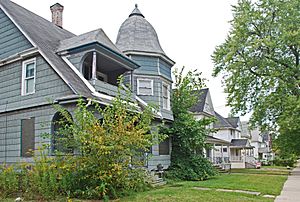
As small car makers joined General Motors, Pontiac grew with the industry. But it also faced hard times during the Great Depression in the 1930s. During World War II, the car industry switched to making war supplies. Pontiac became a key place for wartime production. Its factories made GMC trucks, anti-aircraft guns, torpedoes, and other military items.
After World War II, Pontiac had a good period. More African Americans moved to the city. But the city changed as suburbs grew. People moved to new homes outside the city. This caused businesses in downtown Pontiac to struggle.
In 1963, Pontiac put the Clinton River into concrete in the downtown area to prevent floods. Now, the city is thinking about uncovering the river. This would create a new waterfront area.
In 1969, Pontiac decided to rebuild its downtown area. This plan was called the "Pontiac Plan." In 1965, a professor named C. Don Davidson heard the Detroit Lions football team needed a new stadium. He and city leaders worked to build a new stadium.
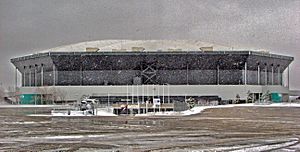
Construction on the Silverdome began in 1972. It opened in 1975. It became the home stadium for the Detroit Lions. It also hosted the Detroit Pistons basketball team and the Michigan Panthers football team. The Silverdome held big events like the 1979 NBA All-Star Game, Super Bowl XVI in 1982, and four matches of the 1994 World Cup.
In 1968, a flu-like sickness called Pontiac fever broke out. Years later, scientists found the same germ that causes Legionnaires' disease was behind it.
In the 1970s, the "Pontiac Plan" started. It included the Phoenix Center, office buildings, and homes. But the rest of the plan was not finished. Since 1980, Pontiac's population has gone down. This is because many jobs, especially in the car industry, were lost.
City Management Changes
From 2009 to 2013, the state government appointed special managers for Pontiac. These managers made important decisions to help the city's money problems. They changed worker contracts and sold city property. For example, the city sold its water plant for $55 million. The police services are now handled by the Oakland County Sheriff's Office. Fire protection is handled by Waterford Township.
These changes helped the city save a lot of money. Pontiac's yearly spending went from $57 million down to $36 million. The city also paid off most of its long-term debt. The Silverdome stadium, once worth $22 million, was sold for only $583,000. It was later taken down.
In 2010, city leaders started "The Rise of The Phoenix" plan. This plan aimed to bring new businesses to downtown Pontiac. They offered free rent and parking to new businesses. This helped bring 52 new businesses to the city.
In 2012, a big project started to fix up the old Sears building. It became the Lafayette Place Lofts. This was the largest building project in downtown Pontiac in about 30 years. It has apartments, a grocery store, and a fitness center.
Geography of Pontiac
Pontiac covers about 20.29 square miles (52.55 square kilometers). Most of this area is land, with a small part being water.
The city is next to Auburn Hills to the east and north. Lake Angelus is to the north. Waterford Township is to the west. Bloomfield Township is to the south.
The area that used to be Pontiac Township now includes Pontiac, Lake Angelus, and Auburn Hills.
Population Changes
| Historical population | |||
|---|---|---|---|
| Census | Pop. | %± | |
| 1840 | 1,904 | — | |
| 1850 | 1,681 | −11.7% | |
| 1860 | 2,575 | 53.2% | |
| 1870 | 4,867 | 89.0% | |
| 1880 | 4,509 | −7.4% | |
| 1890 | 6,200 | 37.5% | |
| 1900 | 9,769 | 57.6% | |
| 1910 | 14,532 | 48.8% | |
| 1920 | 34,273 | 135.8% | |
| 1930 | 64,928 | 89.4% | |
| 1940 | 66,626 | 2.6% | |
| 1950 | 73,681 | 10.6% | |
| 1960 | 82,223 | 11.6% | |
| 1970 | 85,279 | 3.7% | |
| 1980 | 76,715 | −10.0% | |
| 1990 | 71,166 | −7.2% | |
| 2000 | 66,337 | −6.8% | |
| 2010 | 59,515 | −10.3% | |
| 2020 | 61,606 | 3.5% | |
| U.S. Decennial Census 2010-2020 |
|||
In 2020, Pontiac had 61,606 people. The city's population has changed over time. It grew a lot in the early 1900s because of the car industry.
In 2010, there were 59,515 people living in Pontiac. About 34.4% of residents were White, and 52.1% were African American. About 16.5% of the population was Hispanic or Latino. The average age in the city was 33.4 years old.
Culture and Fun
Pontiac used to host the Arts, Beats and Eats Festival. This popular summer festival had art, music, and food. In 2010, the festival moved to Royal Oak.
The city is at the northern end of Woodward Avenue. This famous road goes all the way to Detroit. In the 1950s and 1960s, young people loved to "cruise" and race their hot-rods on Woodward Avenue. Pontiac takes part in the yearly Woodward Dream Cruise. This event celebrates the road's history with a parade of classic cars.
Pontiac has two well-known haunted houses: The Realm of Darkness and Erebus. Erebus was once the world's "Largest Haunted House."
Pontiac has also been a place for making movies. The Motown Motion Picture Studios are located here. Parts of the movies Red Dawn (2012), Into the Storm (2014), Oz the Great and Powerful (2013), and Transformers: Age of Extinction were filmed in Pontiac.
The Michigan Fallen Heroes Memorial is in Pontiac. It honors heroes who have fallen in service.
Education in Pontiac
Students in Pontiac go to schools in the School District of the City of Pontiac. The main high school is Pontiac High School. There used to be two high schools, but they combined into one.
Pontiac also has four charter schools: Pontiac Academy for Excellence, Arts and Technology Academy, Walton Charter, and Great Lakes Academy. Notre Dame Preparatory High School is a private Catholic school in the city.
Transportation in Pontiac
Train Travel
Amtrak offers passenger train service from Pontiac to Chicago. The train, called the Wolverine, runs three times a day.
There used to be a commuter train service from Pontiac to downtown Detroit. This service stopped in 1983. People are still working to bring it back.
Freight trains also use Pontiac. The Grand Trunk Western Railroad has a large yard here. It helps serve the local car industry.
Air Travel
Oakland County International Airport serves Pontiac and nearby areas. It used to be called Pontiac City Airport. This airport is actually located outside Pontiac, in Waterford Township. The larger Detroit Metropolitan Airport is about 35 miles south of Pontiac.
Bus Services
The Suburban Mobility Authority for Regional Transportation (SMART) runs local and regional bus services in Pontiac.
SMART Flex is a newer on-demand transit service. It started in 2021. It helps people get to bus stops, universities, grocery stores, and hospitals. You can book rides using the SMART Flex app.
Roads and Highways
Major roads in Pontiac include Woodward Avenue (M-1), Huron Street (M-59), and Telegraph Road (US 24).
 I-75 connects Pontiac to Flint to the northwest and Detroit to the south.
I-75 connects Pontiac to Flint to the northwest and Detroit to the south. US 24 ends north of Pontiac at I-75. Southbound, it goes through Detroit suburbs and to Monroe.
US 24 ends north of Pontiac at I-75. Southbound, it goes through Detroit suburbs and to Monroe. M-1 (Woodward Avenue) loops around downtown Pontiac. It then goes south directly to Downtown Detroit.
M-1 (Woodward Avenue) loops around downtown Pontiac. It then goes south directly to Downtown Detroit. M-59 runs west to Howell and east to Utica.
M-59 runs west to Howell and east to Utica.
Notable People from Pontiac
- Geri Allen, jazz pianist
- Lawrence S. Bacow, former President of Harvard University
- Mark Bego, author
- Tim Birtsas, baseball player
- Jamal Cain, NBA player
- Madonna Louise Ciccone, singer and actress, lived here as a child
- Sara Lynn Darrow, judge
- DDG, rapper and YouTube personality
- Pete Dexter, writer
- Dez Fitzpatrick, NFL player
- Tommy Edman, baseball player
- Kirk Gibson, baseball player and manager
- Jonas Gray, NFL player
- K. J. Hamler, NFL player
- Laura Innes, actress
- Isaiah Jackson, NBA player
- Elvin Jones, jazz drummer
- Hank Jones, musician
- Hayes Jones, Olympic gold medalist in hurdling
- Thad Jones, jazz musician
- Micki King, Olympic gold medalist in diving
- Rebecca Kleefisch, former Lieutenant Governor of Wisconsin
- Tony Lucca, actor and singer
- Yante Maten, NBA player
- Clara McDaniel, blues singer
- Derek Minor, rapper
- Daniel O'Shea, figure skater
- Kem, R&B/Soul singer
- Gary Peters, United States Senator
- Walker Russell, basketball player
- Walker Russell Jr., basketball player
- Frank Russell, NBA player
- Campy Russell, basketball player
- Bryan Rust, NHL hockey player
- Alfred Taubman, real estate developer
- Wilma Vaught, U.S. Air Force general
- Martell Webb, NFL player
- Tim Welke, baseball umpire
Climate
Pontiac has a "humid continental climate." This means it has warm summers and cold, snowy winters.
| Climate data for Pontiac WWTP, Michigan (1991–2020 normals, extremes 1894–present) | |||||||||||||
|---|---|---|---|---|---|---|---|---|---|---|---|---|---|
| Month | Jan | Feb | Mar | Apr | May | Jun | Jul | Aug | Sep | Oct | Nov | Dec | Year |
| Record high °F (°C) | 66 (19) |
65 (18) |
84 (29) |
89 (32) |
95 (35) |
102 (39) |
104 (40) |
102 (39) |
98 (37) |
90 (32) |
79 (26) |
65 (18) |
104 (40) |
| Mean daily maximum °F (°C) | 31.3 (−0.4) |
34.0 (1.1) |
44.3 (6.8) |
57.6 (14.2) |
69.4 (20.8) |
78.2 (25.7) |
82.3 (27.9) |
80.8 (27.1) |
73.9 (23.3) |
60.5 (15.8) |
47.4 (8.6) |
36.4 (2.4) |
58.0 (14.4) |
| Daily mean °F (°C) | 24.2 (−4.3) |
26.1 (−3.3) |
35.2 (1.8) |
47.0 (8.3) |
59.2 (15.1) |
68.4 (20.2) |
72.6 (22.6) |
71.3 (21.8) |
63.8 (17.7) |
51.4 (10.8) |
39.7 (4.3) |
30.3 (−0.9) |
49.1 (9.5) |
| Mean daily minimum °F (°C) | 17.1 (−8.3) |
18.2 (−7.7) |
26.2 (−3.2) |
36.4 (2.4) |
49.0 (9.4) |
58.6 (14.8) |
62.9 (17.2) |
61.7 (16.5) |
53.7 (12.1) |
42.3 (5.7) |
32.1 (0.1) |
24.3 (−4.3) |
40.2 (4.6) |
| Record low °F (°C) | −21 (−29) |
−22 (−30) |
−8 (−22) |
6 (−14) |
23 (−5) |
34 (1) |
41 (5) |
37 (3) |
29 (−2) |
15 (−9) |
2 (−17) |
−12 (−24) |
−22 (−30) |
| Average precipitation inches (mm) | 2.18 (55) |
1.87 (47) |
2.19 (56) |
2.94 (75) |
3.81 (97) |
3.29 (84) |
3.14 (80) |
3.24 (82) |
2.92 (74) |
2.90 (74) |
3.15 (80) |
2.25 (57) |
33.88 (861) |
| Average snowfall inches (cm) | 12.1 (31) |
9.0 (23) |
4.1 (10) |
0.9 (2.3) |
0.0 (0.0) |
0.0 (0.0) |
0.0 (0.0) |
0.0 (0.0) |
0.0 (0.0) |
0.1 (0.25) |
1.7 (4.3) |
8.1 (21) |
36.0 (91) |
| Average precipitation days (≥ 0.01 in) | 12.5 | 10.0 | 9.5 | 11.3 | 12.6 | 10.5 | 9.7 | 9.8 | 9.2 | 12.0 | 10.3 | 12.4 | 129.8 |
| Average snowy days (≥ 0.1 in) | 8.8 | 7.2 | 3.7 | 0.9 | 0.0 | 0.0 | 0.0 | 0.0 | 0.0 | 0.1 | 1.6 | 6.7 | 29.0 |
| Source: NOAA | |||||||||||||
Images for kids
-
The Pontiac State Hospital, around 1912
-
Houses in the Fairgrove Avenue Historic District
-
The Pontiac Silverdome in 2006
See also
 In Spanish: Pontiac (Míchigan) para niños
In Spanish: Pontiac (Míchigan) para niños



